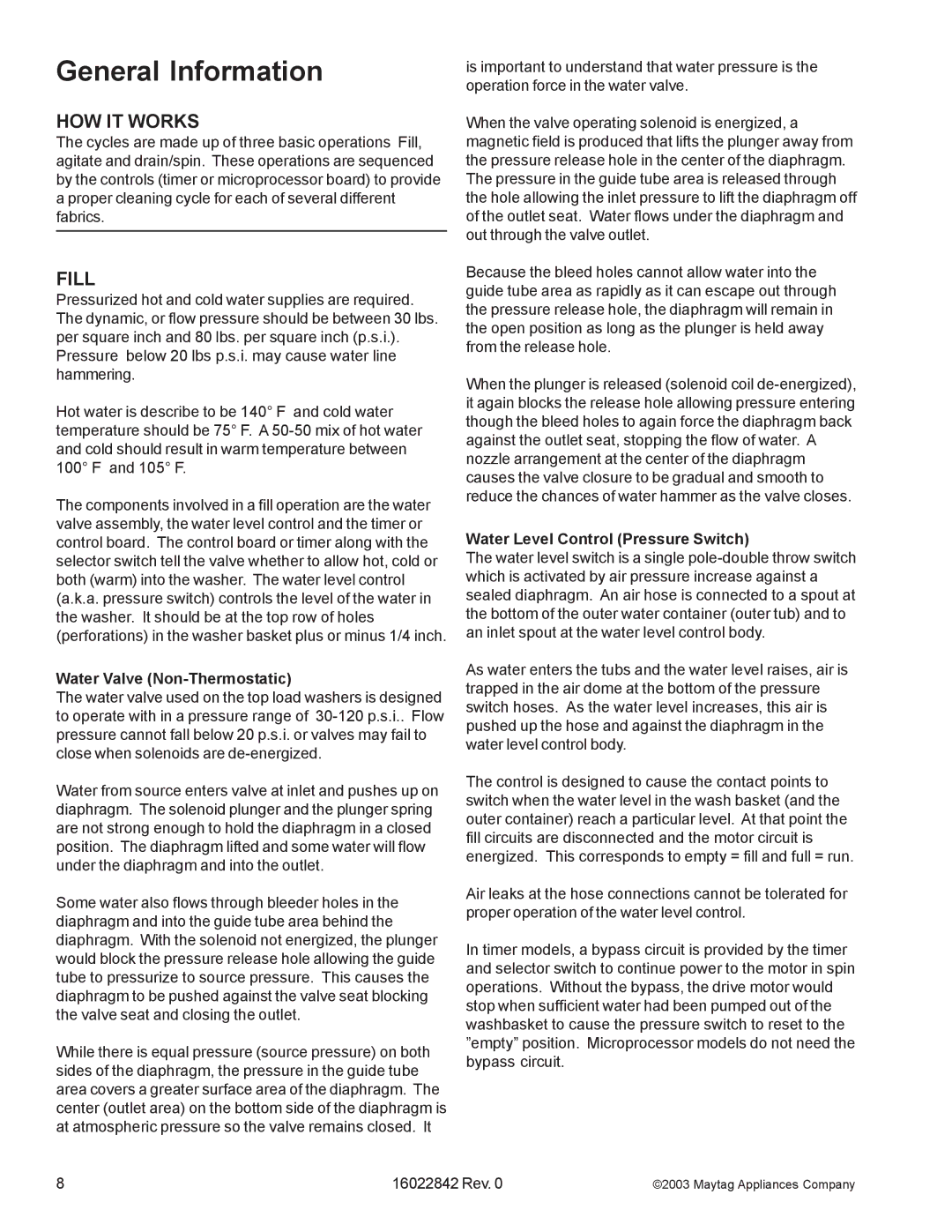General Information
HOW IT WORKS
The cycles are made up of three basic operations Fill, agitate and drain/spin. These operations are sequenced by the controls (timer or microprocessor board) to provide a proper cleaning cycle for each of several different fabrics.
FILL
Pressurized hot and cold water supplies are required. The dynamic, or flow pressure should be between 30 lbs. per square inch and 80 lbs. per square inch (p.s.i.). Pressure below 20 lbs p.s.i. may cause water line hammering.
Hot water is describe to be 140° F and cold water temperature should be 75° F. A
The components involved in a fill operation are the water valve assembly, the water level control and the timer or control board. The control board or timer along with the selector switch tell the valve whether to allow hot, cold or both (warm) into the washer. The water level control (a.k.a. pressure switch) controls the level of the water in the washer. It should be at the top row of holes (perforations) in the washer basket plus or minus 1/4 inch.
Water Valve (Non-Thermostatic)
The water valve used on the top load washers is designed to operate with in a pressure range of
Water from source enters valve at inlet and pushes up on diaphragm. The solenoid plunger and the plunger spring are not strong enough to hold the diaphragm in a closed position. The diaphragm lifted and some water will flow under the diaphragm and into the outlet.
Some water also flows through bleeder holes in the diaphragm and into the guide tube area behind the diaphragm. With the solenoid not energized, the plunger would block the pressure release hole allowing the guide tube to pressurize to source pressure. This causes the diaphragm to be pushed against the valve seat blocking the valve seat and closing the outlet.
While there is equal pressure (source pressure) on both sides of the diaphragm, the pressure in the guide tube area covers a greater surface area of the diaphragm. The center (outlet area) on the bottom side of the diaphragm is at atmospheric pressure so the valve remains closed. It
is important to understand that water pressure is the operation force in the water valve.
When the valve operating solenoid is energized, a magnetic field is produced that lifts the plunger away from the pressure release hole in the center of the diaphragm. The pressure in the guide tube area is released through the hole allowing the inlet pressure to lift the diaphragm off of the outlet seat. Water flows under the diaphragm and out through the valve outlet.
Because the bleed holes cannot allow water into the guide tube area as rapidly as it can escape out through the pressure release hole, the diaphragm will remain in the open position as long as the plunger is held away from the release hole.
When the plunger is released (solenoid coil
Water Level Control (Pressure Switch)
The water level switch is a single
As water enters the tubs and the water level raises, air is trapped in the air dome at the bottom of the pressure switch hoses. As the water level increases, this air is pushed up the hose and against the diaphragm in the water level control body.
The control is designed to cause the contact points to switch when the water level in the wash basket (and the outer container) reach a particular level. At that point the fill circuits are disconnected and the motor circuit is energized. This corresponds to empty = fill and full = run.
Air leaks at the hose connections cannot be tolerated for proper operation of the water level control.
In timer models, a bypass circuit is provided by the timer and selector switch to continue power to the motor in spin operations. Without the bypass, the drive motor would stop when sufficient water had been pumped out of the washbasket to cause the pressure switch to reset to the ”empty” position. Microprocessor models do not need the bypass circuit.
8 | 16022842 Rev. 0 | ©2003 Maytag Appliances Company |
